Writing chamber
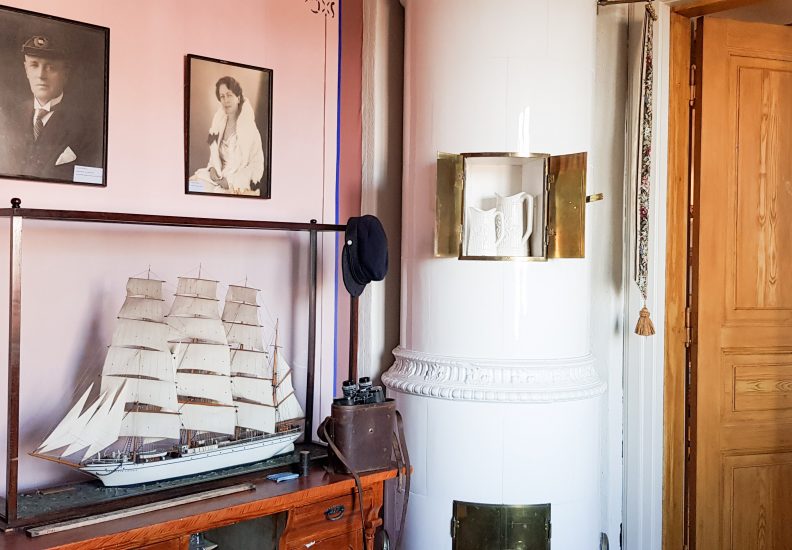
Writing chamber
The north-western chamber, which was originally a bedroom and later became Ebba’s bedchamber, is nowadays decorated like Erik Petter’s and, after that, Erik August’s office. In this room, the shipowner sat with his accounts and received visitors. The room has a writing desk featuring seafaring literature, bookkeeping papers, old calendars from the times of the shipping company, and stationery. ...
Beverage serving tools and chairs for the shipowner’s guests are also present. A portrait of shipowner Gustaf Eriksson and his wife is hanging on the wall. A similar portrait was placed on the captain’s saloons on Gustaf Eriksson’s sailing ships. The desk is originally from Gustaf Eriksson’s famous vessel Herzogin Cecilie. These two compasses and the sextant were used on a sailing ship. The blue chest contains nautical charts from the world’s seas. Warm water in a jug was stored inside the tiled stove. The room has also been used as a bedroom. Smaller objects and the living room suite were here before the fire.
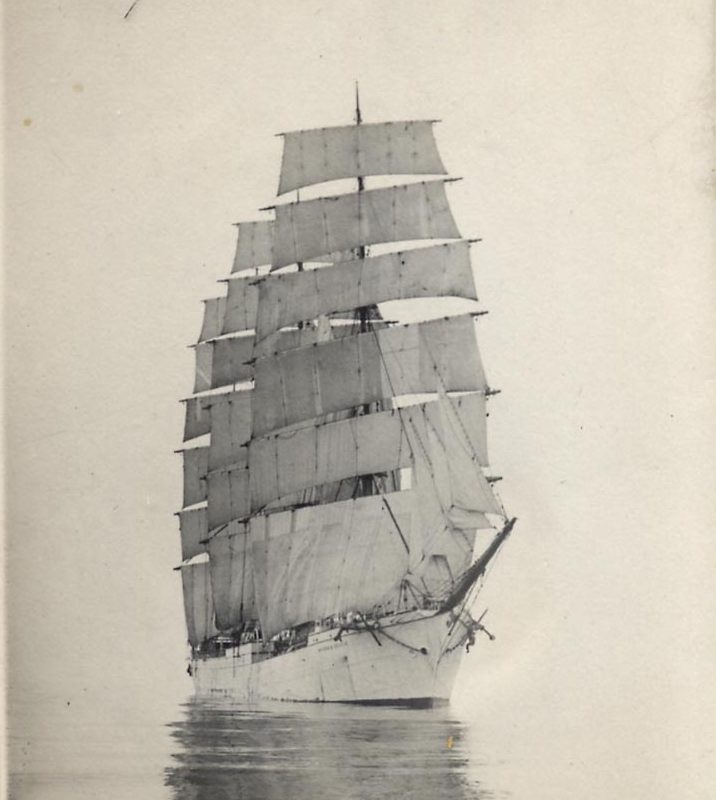
Herzogin Cecilie and Pellas
Sven Eriksson, born at Pellas in 1903, became known as the young captain of Herzogin Cecilie. It was the flagship of Ålandian major shipowner Gustaf Erikson’s grand sailing fleet. Sven started his seaman career on the barque Prompt. After that, he sailed as a mate on Killoran, Baltic, and Jenolin before becoming the youngest captain of Gustaf Erikson’s sailing ship in 1929.
Sven was Herzogin Cecilie’s captain when the vessel ran aground on the coast of Devon, England in 1936. Sven’s wife Pamela Eriksson was on board on the vessel’s last journey. The couple had met on the boat on an earlier voyage, when Pamela was aboard as a passenger. After the shipwreck of Herzogin Cecilie, Sven and Pamela Eriksson came home to Pellas before moving to South Africa with their two children after the Second World War.
To Sven and the family, the shipwreck was a sad event that cast a shadow on their lives. At that time, a shipwreck was big news, and the spot attracted legions of people who wanted to see the vessel and watch the rescue work that lasted for months. After Herzogin Cecilie, Sven did not act as a captain again but became a farmer, first at Pellas and later on his own farm in South Africa. He died in South Africa in 1954 and is buried in the family grave in the Lemland cemetery. His wife, Pamela, lived the last years of her life in Åland and died in 1984. The excerpt from Lundberg’s book below describes how Sven introduced his wife, whom Lemland’s farmers considered exotic and different.
Ni ska tro att det blir uppståndelse när Stella kommer till Granboda. Som skökan i Babylon i hatt och eldröd sidenklänning står hon i Lemlands kyrka medan prästen läser upp lysningen för henne och Josef. Och Josef njuter, han har slagit hela bygden med häpnad och fått alla halsar att vändas. […] ”Ja, nog er det en vacker körka, fan ta mig”, konverserar hon […] Och mera i samma stil som ger oss anledning att betvivla att hon är döpt och konfirmerad. Hon använder vad hon har lärt sig av jungmän och matroser, för med Josef och styrmännen talade hon engelska. […] Nu står hon i Simons sal och säger: ”Her har jag bodd i ett tidigare liv. Ner jag kom in tenkte jag att no er jag hemma.
Ulla-Lena Lundberg in her book Stora världen.
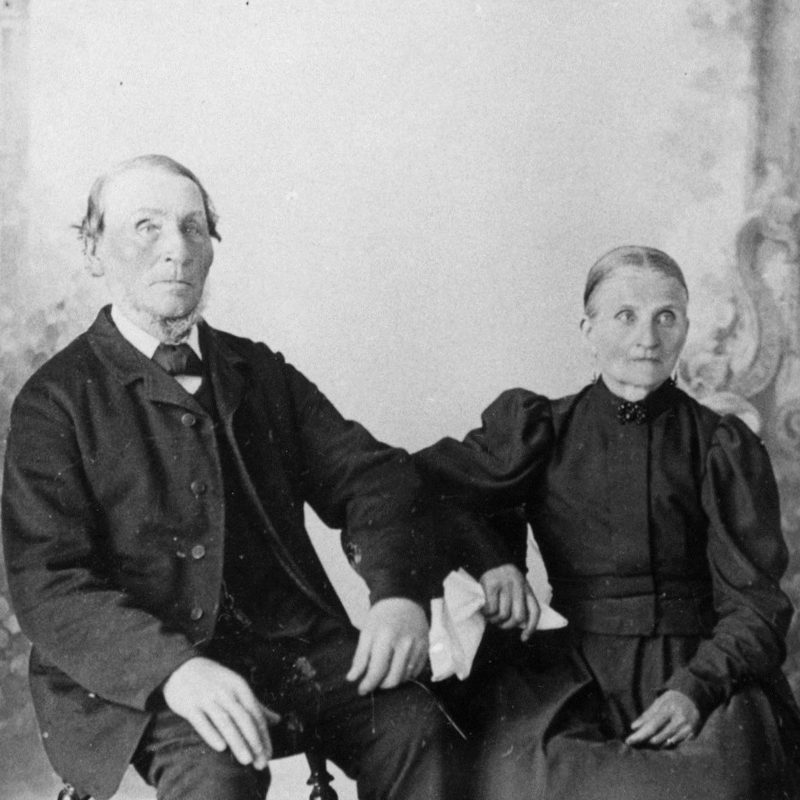
Erik Petter Eriksson
Erik Petter Eriksson was born in 1823 as the oldest sibling of five. Erik Petter was very young when he got the possession of his fathers’ farm, Pellas. The father died in 1837 and left behind a house burdened with debt. According to the story, the intention was to sell the farm and its movables at auction, but enterprising 15-year-old Erik Petter managed to talk all creditors into waiting with their payment demands. Erik Petter’s plan was to build a cargo vessel and save money to pay his father’s debts.
Erik Petter married Brita Stina Persdotter (born in Rörstorp in 1830 and died in 1913). The couple had two children, August and Erika, who lived to adulthood. August started taking care of the farm, and Erika moved to the Hansas farm in Granboda after getting married.
For Erik Petter Eriksson, Trefanten was the first vessel of which he was head shipowner. Erik Petter Eriksson’s vessel Fredrika used to be Lemland’s biggest vessel and the first schooner in the district. In 1869 and for two years after that, Erik Petter Eriksson was the head shipowner of the brand-new schooner, Leo. He and the other shareholders had the vessel built in Sideby. From 1874 to 1875, Erik Petter Eriksson was the head shipowner of ten vessels, seven of which were built in Sideby. Erik Petter Eriksson’s last vessel, Freja, was built in Söderby, Lemland.
Erik Petter had a good reputation as an honest man, and he made good profits with his vessels. He was called the “bank of Lemland” because he ran his own private loan business for other peasant shipowners who wanted to build vessels. He could write, which was not common in the region that time. He was self-educated and held auctions, drew up estate inventories, and performed distributions on estates in Lemland and Lumparland. When the profitability of small wooden peasant vessels decreased, Erik Petter thought that it was time to invest his money in a new house instead of building new vessels. Erik Petter died in 1908.
The following excerpt from Leo describes Erik Petter’s thoughts on building the Pellas house:
Erik Petter har fortfarande kvar en del av skulden därför att det är mera lönsamt att satsa på nya skepp än att använda hela överskottet till skuldens betalning. Han känner inte längre ett lika skriande behov av att göra sig fri från den. Stora penningsummor har upphört att förskräcka honom, och sedan länge är seglationen ett större intresse än skulden. Men föresatsen står fast: innan skulden är betald byggs här inget hus.
Ulla-Lena Lundberg in her book Leo.
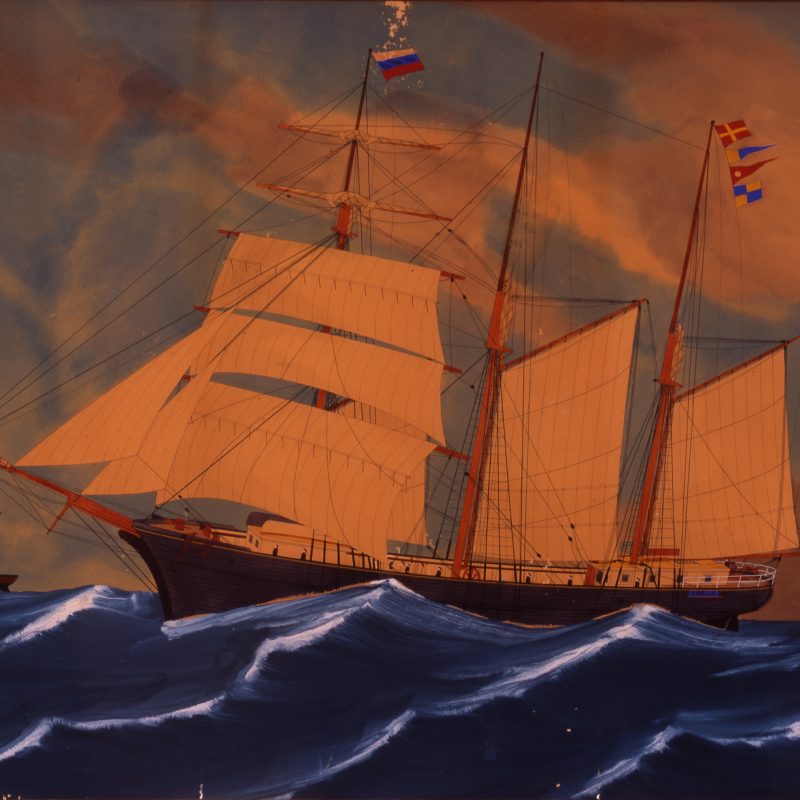
Peasant seafaring at Pellas
While operating as a shipowner, Erik Petter Eriksson was the head shipowner of the following vessels: Trefanten, Fredrika, Augusta, Leo, Linnea, Elina, Ceres, Åland, Eli, Cedia, Primus, Elida, Wendla, and Freja. In addition, he was a shareholder of many vessels. Of Erik Petter Eriksson’s vessels, Leo was the most infamous; it was called “Människoätaren” (maneater) because it had a reputation for claiming lives on each trip. Despite its bad reputation, Leo was a successful vessel, also called Money Dragon because it was Erik Petter Eriksson’s most profitable ship.
A couple of Pellas’ vessels were built in Lemland. These included Erik Petter Eriksson’s first sailing ship, schooner Trefanten, and Fredrika, the first schooner in the district. Seven sailing ships were ordered from Sideby, Ostrobothnia. Several sailing ships for Ålandian shipping companies were built in Sideby. After 1874, Pellas’ shipping company operations were reduced, and when the new Pellas main building was built, Erik Petter Eriksson directed two ships.
The last vessel in Pellas’ ownership was Freja. Erik Petter Eriksson’s son August became the shipowner after his father. When the profitability of small, farmer-owned wooden vessels decreased at the end of the 19th century, August Eriksson left the sea and became a full-time farmer at Pellas. Many of August Eriksson’s sons became sea captains, and the shipmaster tradition continued through them.
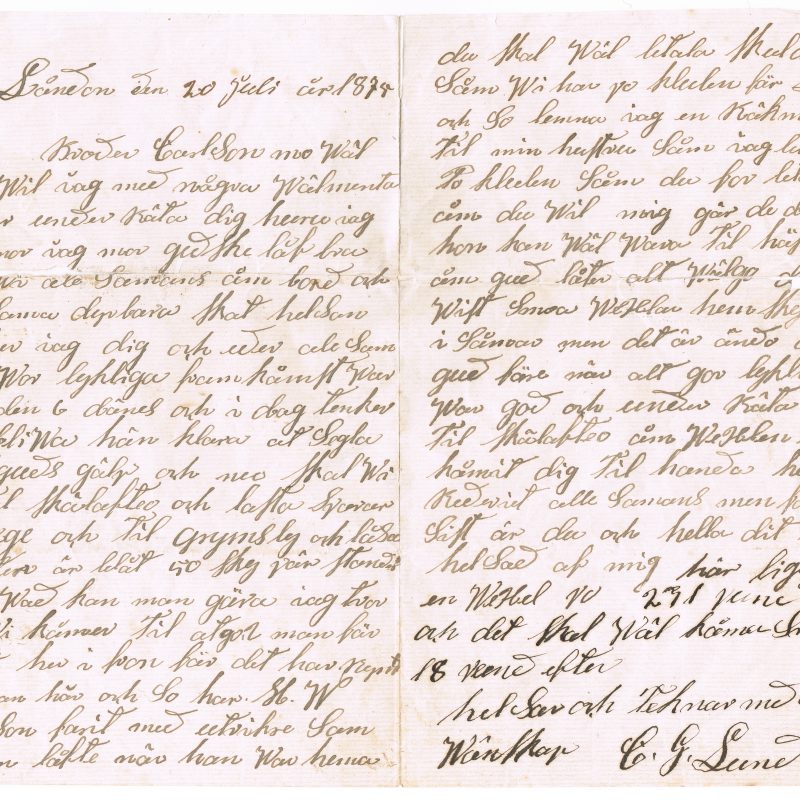
Peasant seafaring
Peasant seafaring was a form of seafaring that Ålandian farmers practised in the second half of the 19th century and at the beginning of the 20th century. During the golden age of peasant seafaring, a successful vessel could earn its acquisition costs in two or three seasons. The cargo ship traffic mainly focused on the Baltic Sea and the North Sea, but some voyages were made farther. Lemland and Vårdö were Åland’s biggest seafaring municipalities during the peasant seafaring period.
All population segments participated in peasant seafaring in one way or another. Men were shipowners or seamen, and women helped in equipping ships. Being a shipowner did not mean you were the only owner of a vessel; rather, you owned shares of it. The head shipowner was the primary owner, he was mainly responsible for the vessel, and he also received the biggest profits. It was possible to own shares of several vessels: a sixth, an eighth, a sixteenth, a thirty-second, and so on. The shareholding system made it possible for all classes to own shares.
Peasant vessels usually transported timber or firewood that was loaded to the ship on the coasts of Norrland, Västerbotten, or Ostrobothnia, and resold in Denmark, England, Germany, or other countries on the North Sea coastline. Peasant vessels mainly sailed on the Baltic Sea and North Sea.
Överallt på Åland tycktes pojkar vara sjöman och snickare av naturen, men på Lemland låg gräddan av sjöfarare som ett tjockt lager över befolkningen. Var och varannan karl var sjökapten eller redare.
Pamela Eriksson in her book The Duchess: The Life and Death of the Herzogin Cecilie.
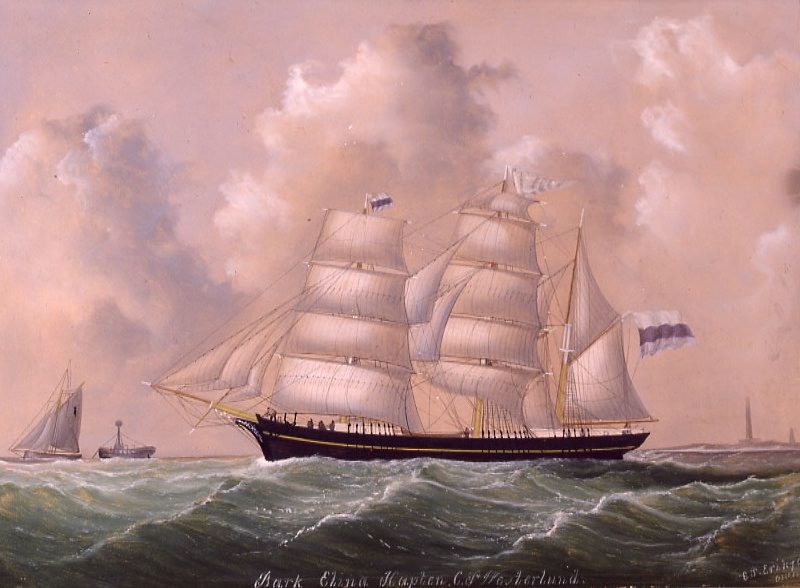
Erik Petter’s sailing ships
The schooner, 106 lasts, was built in Lemland in 1838, and clinker construction was applied in 1843. At that time, the vessel was owned by Per Andersson from the Andersas farm in Flaka. In 1851, Erik Petter Eriksson married Per Andersson’s daughter. Erik Petter became the owner of Trefanten, but it is unknown whether this happened before or after the marriage. Trefanten was shipwrecked in a dramatic snowstorm on 4 December 1871 at cable length (approximately 200 metres) from the coast of Öland. The vessel was thrown aground and so severely damaged in the storm that it immediately filled with water. The ship’s crew of eight made it ashore to Öland by their own efforts. Johan Jansson (Johansson Friman) was the captain of Trefanten when the accident happened. The wreck was soon sold to an Ålandian at an auction. The same stormy night, two other vessels were shipwrecked in the same area; Swedish Sädesärlan’s crew survived, and the Finnish vessel Oskar’s whole crew died. Per Anton Lignell from Åland was the captain of Oskar.
Fredrika, schooner, 114 lasts
The vessel was built in Bergören, Granboda in 1859. It was clinker-built and the first schooner in Lemland. Erik Petter Eriksson was its master builder and head shipowner. In 1875, E.G. Söderlund became the head shipowner. The vessel ran aground and became a wreck near Starholmen on 15 December 1879. Jansson was the captain.
Alexandra, galleass, 67 lasts
The construction site and year are unknown. E.P.E bought the vessel and brought it to Lemland. The vessel was shipwrecked in 1868 while transporting a load of wood over the Sea of Åland to Stockholm.
Eugenia, barque, 190 lasts
The vessel was built in Sastmola in 1865 for Lemland’s shipping company, whose head shipowner was E.P.E. Eugenia was shipwrecked off Gotland on 29 December 1872 when it was ballasted on its way home from Grimsby. The captain was Anders Nylund.
Alina, barque, 367 nrt
The vessel was built in Skaftung, Ostrobothnia in 1866. E. Silverberg was the master builder. The vessel was built for Lemland’s shipping company, whose head shipowner was E.P.E., and was sold to Norway in 1872.
Elina, barque, 357 nrt
The vessel was built in Sideby in 1866 (Josef Jansson is thought to have been the master builder) for Lemland’s shipping company, whose main shipowner was Erik Petter Eriksson. E.G. Eriksson from Flaka became the head shipowner in 1870, followed by Anders Nylund from Knutsboda in 1878. The vessel ran aground and was wrecked on Jutland’s north-western coast in February 1882, with Mats Sjölund as the captain.
Leo, schooner, 289 nrt
The vessel was built at the Kilens shipyard in Sideby in 1870. Josef Jansson was the master builder. It took only six months to build the vessel, and it was ready to sail on 20 July. The shipping company’s construction supervisor was shareholder Carl Carlsson from Kallas, Granboda. In addition, he was the vessel’s captain for the first two years. Leo was considered to be a vessel that brought good luck, which is why it was commonly called Penningdraken (Money Dragon). Erik Petter Eriksson and Carl Carlsson acted as the head shipowners by turns, and from 1885, Erik August Eriksson was the head shipowner. Leo was taken out of service in 1898, and its wreck is located in the strait of Lumparsund.
Linnéa, schooner, 300 nrt
The vessel was built at the Kilens shipyard in Sideby in 1872. It was made for Lemland’s shipping company, whose head shipowner was Erik Petter Eriksson. Josef Jansson was the master builder. Anders Johan Eriksson from Söderby was the shipping company’s supervisor of construction. He bought the vessel in 1895 Linnéa was taken out of service in 1897.
Ceres, schooner, 273 nrt
The vessel was built at the Kilens shipyard in Sideby in 1873. It was made for Lemland’s shipping company, whose head shipowner was Erik Petter Eriksson. Josef Jansson was the master builder. Johan Johansson Friman (who used the name Jansson for a short period of time) supervised the construction in Sideby. He was the vessel’s first shareholder (5/32) and its captain for the first 21 years. The vessel was commonly considered “a ship that brings wealth”. Ceres was taken out of service in 1897.
Åland, schooner, 311 nrt
The vessel was built in Sideby in 1873. The construction site and master builder are unknown; Erik Petter Eriksson was the head shipowner. The supervisor was A.J. Eriksson, who later became the vessel’s first captain. Åland ran aground and was shipwrecked on 13 July 1882, near Ulkokrunni pilot station in the Uleåborg archipelago.
Cedia, schooner, 228 nrt
The vessel was built at the Kilens shipyard in Sideby in 1874. Josef Jansson was the master builder. Carl Gustaf Nylund from Granboda supervised the construction, and he became the vessel’s first captain. Shipbuilder Josef Jansson (1/4) and some other people from Sideby were Cedia’s shareholders. Businessman Berndt Sundahl was one of the major shareholders. The vessel was shipwrecked on the North Sea on 10 March 1879 and repaired, then taken out of service in 1897.
Eli, schooner, 190 nrt
The vessel was built at the Flada shipyard in Sideby in 1874. Karl-Johan Jossfolk was the master builder. Erik Petter Eriksson was Eli’s head shipowner and E. Sjölund its first captain. The vessel survived without extensive damages and was taken out of service in 1897.
Augusta, barque, 374 nrt
The vessel was built at the Werkflada shipyard in Närpes in 1874. Mats Ivars was the master builder. The vessel had 18 shareholders, all but one of whom were from Lemland. Shipmaster Erik August Eriksson from Granboda was the vessel’s head shipowner from 1874 to 1879. He was the biggest shareholder, with 24/288 shares. Erik Petter Eriksson became the head shipowner in 1880, and he also was one of the biggest shareholders. Augusta was sold to France in 1900 for 3200 francs.
Primus, schooner, 237 nrt
The vessel was built at the Långvik shipyard in Närpes in 1874. Rural tradesman Berndt Sundal and Erik Petter Eriksson from Granboda were the owners. E.P.E was the first head shipowner. Later, Berndt Sundal became the head shipowner, and after him, K.G. Lundberg. The vessel was sold after running aground on 16 December 1888 by Barhöft near Stralsund.
Wendla, schooner, 197 lasts
The vessel was built in Lillholmen, Vessingboda in 1875 by a shipyard whose head shipowner was Erik Gustav Mattson from Mellangård. The schooner was sold to Erik Petter Eriksson, then sold and taken out of service in 1896.
Freja, schooner, 263 nrt
The vessel was built in Söderby sjö, Lemland in 1882–1883. Isak Nordström from Ostrobothnia was the master builder. Söderby’s farmers/sea captains, Emil Nylund from Seffer and Matts Sjölund from Skallfogdas/Mattas, set the building project in motion as they signed a timber supply contract with farmer Anders Nylund from the Nybonds farm in Söderby. According to the contract, Nylund would supply half of all timber, approximately 140–150 standards, for the construction of a ship, and the price was “3,000 Finnish gold marks”. The shipyard had about ten owners, most from Granboda. Erik Petter Eriksson and Erik August Eriksson were the head shipowners. Emil Nylund became the captain for the first 15 years. Nylund was from Seffers, Söderby, and he owned approximately 1/4 of the vessel. On 3 February 1906, Freja was sold to shipmaster Karl Johan Johansson from Hellestorp (12/96 shares) and others at the price of 8,030 Finnish marks. In 1908, inn owner Erik August Eriksson became the head shipowner. Freja and its crew of eight were shipwrecked in a violent snowstorm on 9 October 1909 by Jurmo near Utö. Karl Oskar Johansson from Hellerstorp was the vessel’s captain and major owner.
Tähti, barque, 489 nrt
The vessel was built in Vasa in 1857. Erik Petter Eriksson and others bought the vessel and brought it to Lemland in 1890. The price was 15,000 Finnish marks. The vessel was shipwrecked by Windau in 1897, and the SS Titano rescued the crew. Tähti was Erik Petter’s largest vessel.
